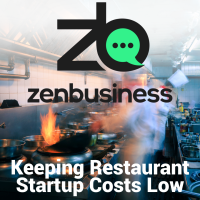From Idea to Kitchen: Keeping Restaurant Startup Costs Low
Starting a restaurant doesn’t have to drain your life savings. The smartest restaurateurs build lean, iterate fast, and protect themselves from risk before spending big.
When you’re launching, your structure matters as much as your menu. Many owners simplify setup by using ZenBusiness to form an LLC — a quick, affordable way to protect personal assets and stay compliant without hiring a costly attorney.
TL;DR
-
Test before investing — start with pop-ups, food stalls, or ghost kitchens.
-
Keep your first menu small and efficient.
-
Negotiate leases and supplier terms relentlessly.
-
Form an LLC early to separate business liability.
-
Use low-cost tools and digital systems to manage operations.
Choosing Your Business Structure (and Why It Saves You Money)
Before you buy your first oven, establish your legal footing. Setting up as an LLC (Limited Liability Company) gives you tax flexibility and shields personal assets from lawsuits or debt.
Hiring a lawyer for formation can cost $1,000 or more, while using an online service such as ZenBusiness handles filings, compliance, and EIN registration for a fraction of that. It’s one of the few early expenses that pays for itself in peace of mind.
The Lean Launch Model
You don’t need a 3,000-square-foot dining room to build a loyal following. Test your concept small, prove demand, and expand when the math makes sense.
|
Launch Model |
Startup Cost Range |
Ideal Use |
Key Strategy |
|
Pop-up Stall |
$5K–$15K |
Market validation |
Partner with a bar or brewery for weekend service |
|
Food Truck |
$40K–$80K |
Mobile concept |
Start near offices or events with high foot traffic |
|
Ghost Kitchen |
$20K–$60K |
Delivery-only |
|
|
Micro Café |
$80K–$150K |
Niche concept |
Focus on high turnover and simple seating |
How-To: Build a Restaurant Without Breaking the Bank
Step 1: Validate Before Leasing
Host pop-ups or collaborate with shared kitchens you can find via The Kitchen Door. Test menu pricing, collect reviews, and confirm repeat demand before committing to a full lease.
Step 2: Simplify Your Menu
Limit yourself to 8–12 items that share ingredients. Reducing SKUs cuts waste and storage needs. You can still offer weekly specials to create variety.
Step 3: Buy Smarter, Not Newer
New kitchen equipment depreciates fast. Check trusted marketplaces like WebstaurantStore or Restaurant Equipment World for refurbished gear.
Step 4: Control Labor Early
Cross-train your core team so that one person can prep, serve, and close. Scheduling tools such as 7shifts or Homebase help balance labor costs without chaos.
Step 5: Focus on Marketing You Can Afford
Start with organic visibility. Claim your business on Google Maps and keep menus updated on Yelp. Use free design software like Canva to make professional social graphics.
Step 6: Manage Finances from Day One
Use free accounting tools like Wave or scalable systems such as QuickBooks Online. Track cash flow weekly — not quarterly.
Cost Control Checklist
Formation & Compliance
- Register an LLC through ZenBusiness or your state portal
- Apply for local food service permits
Location & Lease
- Compare short vs. long-term lease options
- Verify kitchen ventilation and health code standards
Equipment & Setup
- Purchase refurbished items where possible
- Confirm warranties and energy efficiency ratings
Staffing & Payroll
- Implement scheduling software for cost tracking
- Keep initial hires under five until demand stabilizes
Marketing & Sales
- List on Google Business Profile
- Build a simple site via Wix or Squarespace
- Collect customer emails from day one
Frequently Asked Questions
What’s the smallest realistic budget for starting out?
Pop-ups and ghost kitchens can launch under $20,000, especially if you rent kitchen time and avoid long leases.
Should I lease or buy my restaurant space?
Lease first — it preserves flexibility. Buying limits your ability to pivot or relocate.
How can I market effectively with no budget?
Lean on local SEO, social media storytelling, and food photography shot on your phone. Tools like Canva or free Mailchimp tiers make this simple.
What licenses are mandatory?
You’ll typically need a business license, food service permit, and health department approval. Check your city’s small business portal for details.
Glossary
-
LLC: Legal entity protecting your personal assets and simplifying taxes.
-
Ghost Kitchen: Delivery-only kitchen operating without dine-in service.
-
POS (Point of Sale): System for handling transactions, tips, and receipts.
-
Overhead: The ongoing costs of running your business (rent, payroll, utilities).
-
Lean Launch: Testing a concept on a small scale before committing to major fixed expenses.
In Practice
By starting lean, controlling costs, and structuring smart, you’re setting your restaurant up for durability — not just launch-day excitement. A clear legal structure (like an LLC formed through ZenBusiness), a tested concept, and a tight operational model let you scale at your own pace, not the landlord’s.
Discover how the Scottsdale Area Chamber of Commerce can elevate your business with unparalleled access to influential leaders, advocacy, and a thriving network since 1947!


